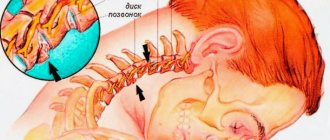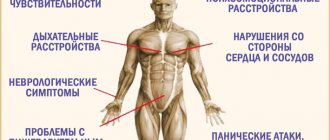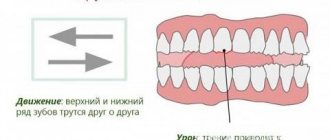How does stuttering manifest itself and what is it?
People who stutter have an irregular speech rhythm.
Instead of a smooth, measured flow, it stumbles, gets stuck on individual sounds and words, which creates painful psycho-emotional tension from a person’s inability to speak out. In this case, the coordinated work of the articulatory apparatus, breathing and voice is disrupted.
Convulsive muscle movements, a grimace on a reddened face and swollen veins in the neck, ragged breathing and a tense voice - this is what stuttering looks like.
In speech therapy, stuttering is a speech disorder expressed in repetition or prolonged pronunciation of sounds and syllables; or speech whose rhythm is disrupted by frequent stops and hesitation in pronunciation.
If stuttering has neurotic roots, then it is logoneurosis.
Are there any other reasons other than “nerves”? Eat.
Symptoms
The development of each child is individual. Someone may have symptoms of stuttering that are part of a child's normal speech and language development. If symptoms last between 3 and 6 months, the child may later have problems developing a stutter.
Symptoms of stuttering can vary throughout the day and in different situations.
These may include:
- Repetition of sounds, syllables or words, for example, repetition of a sound, as in V-V-V-Vanya.
- Prolonging sounds, for example, MMMama.
- Using interjections such as “well” or “ugh”, for example: I want, well...
- Speech is too slow or with too many pauses.
- Stopped or blocked speech. The mouth opens to speak, but nothing comes out.
- Chances of feeling out of breath or nervous when speaking.
- Rapid blinking of the eyes or trembling of the body or trembling of the lips when speaking.
- Increased stuttering when tired, excited or stressed.
- Fear to speak.
- Symptoms of stuttering can be similar to other health conditions. To confirm the diagnosis, you should see a doctor.
Species characteristics
With logophobia, the baby will consciously ignore “difficult” sounds; due to their replacement or omission, speech will become slurred. There will be a fear of oral communication. Embolophrasia is a pathological condition in which a child inserts certain phonemes into words.
Classification of types of stuttering according to the nature of articulatory muscle spasms:
- Clonic stuttering - if there is a repetition of the first sounds or syllables in words; extends to the entire speech apparatus; often noted at the initial stage of pathology development (pa-pa-pa).
- Tonic stuttering – with characteristic pauses in the middle of a word; they can be short in the form of a jerk or prolonged spasms; the speech of such a child is tense; the cramps even affect the abdominal muscles (paaaaaaah).
- Mixed – occurs as a result of a long course of the disease.
Characteristics by localization of seizures:
- respiratory form;
- articulatory;
- voice;
- mixed.
With increased muscle tone of the articulatory apparatus, the facial muscles become distorted, and convulsions of the lips, tongue and soft palate occur. The respiratory type of stuttering is characterized by a sharp and noisy breath in the middle of a conversation and the occurrence of pauses. The main symptom of the vocal form is convulsions when pronouncing a vowel sound, there is a complete loss of voice or its intermittency. This form is less common than others.
Working on the sound "r"
After warming up, start making sounds. The most problematic sound is the “r” sound; it is trained with special exercises.
Important! There is a smile on the lips, the teeth are visible, the jaw is motionless.
Important! The lips are motionless, the tongue touches the outside of the teeth.
- stretch your lips in a smile;
- stick out your tongue and place its wide front edge on your lower lip. At the same time, pronounce the sound “f” for so long that you can blow the cotton wool onto the opposite edge of the table.
- 5. "Bird":
- open your mouth, place a wide tongue on your upper lip and move it back and forth along the lip;
- at the same time, without lifting your tongue from your lips, perform stroking movements;
- do the exercise slowly at first, then increase the pace and pronounce bl-bl-bl like a dove.
- 6. "Musicians":
- open your mouth in a smile, drum the edge of your tongue on the upper alveoli and try to say a sound similar to English D;
- The exercise resembles a drum roll, increase the speed each time.
Important! Do not puff out your cheeks, make sure that the child pronounces the sound “f”.
Open your mouth a little and move your tongue across your lips, as if you were licking jam. You can drop a drop of honey or jam on the child’s lips.
Important! Hold the lower jaw with your finger, if it tries to help the tongue, the tongue does not touch the corners of the mouth.
Important! The tongue licks the lip well, does not fall forward or go to the side.
Important! The tongue strike is clear, like a drum roll, no extraneous sounds except D are heard. When performing the exercise, a strong air stream is formed, the mouth does not close. When performed correctly, a piece of paper brought to the mouth is rejected.
Kinds
Doctors distinguish two types of disorders:
- Neurotic (logoneurosis). When the baby has no obvious neurological abnormalities. What is the impetus for the development of the disease? Yes, any severe stress! Perhaps the parents overdid it with teaching. For example, early learning of other languages is now fashionable. It is believed that the baby's memory is quite well developed. Not like adults)) Yes, that's true. But not every baby is psychologically ready. Or perhaps the culprit was frequent viewing of non-children's cartoons.
By the way, this species fades out during the child’s rest period. And with any excitement, stuttering intensifies. For example, when the little one is overexcited and wants to talk a lot. Here the speech cannot keep up with the train of thoughts and, as a result, he stutters.
- Neurosis-like or organic. And here the reason lies in physiological disorders. That is, these are both problems with pregnancy and hereditary predisposition.
Yes, these are the main types of the disease. But every baby stutters differently. Someone draws out a syllable, someone repeats the same thing. Therefore, there are also types or forms based on the type of speech.
Diagnosis of stuttering in children and adults
The main symptoms of the disease are the same at any age. These are hesitations that disrupt the smooth flow of speech: repetitions, protracted sounds, stops on the initial syllable. The process is accompanied by involuntary contraction of the facial muscles, tension in the arms, and an irregular breathing rhythm. Fear, anxiety, worry are the emotions that accompany stuttering.
It should be noted that at the age of 2-5 years, when a child is just learning to speak, repeated repetition of words, increased emotionality in the absence of any tension and speech that is not at all fluent is normal.
We suggest that you familiarize yourself with Facial nerve neuritis: symptoms and treatment
Stuttering in adults is more complex and is accompanied by anxiety, rapid heartbeat, a feeling of suffocation, and chaotic movements. Panic in crowded places, withdrawal from communication, difficult adaptation in society - all this only emphasizes the seriousness of the problem of stuttering and forces you to look for ways to overcome it in order to stop stuttering forever.
Other ways to combat stuttering
- Drug treatment . Acupressure is used as a medicinal treatment. This is a long process, but its effectiveness is great. It can be performed either by a specialist in his field or independently.
- Modern technologies . There are a huge number of gadgets aimed at solving the problem of stuttering. Everyone's functional load is different. Some record a person's speech and produce it with shorter pauses. A person’s task is to hear a recording of his speech and repeat after it. Over time, the pause will become shorter, and with it the benefit of the stuttering person will decrease.
Other programs, on the contrary, create stressful situations for a person. They cause a number of emotional manifestations in him: fear, anger, crying, laughter, irritation. They teach a person to keep his speech within the limits of what is permitted, and train him in this.
Diagnostic measures
At the initial stage of diagnosis, you should seek help from your local physician. After examination and questioning, he will refer the patient to other specialists, depending on the causes of stuttering. Most often, neurologists, speech therapists, psychologists and psychotherapists treat pathology. Diagnostic steps include the following approaches:
- Collection of complaints and medical history. It is important to find out the time of appearance of clinical signs, the situations with which the patient himself associates their occurrence, as well as what methods the patients tried to be treated before the current request for medical help. It is recommended, if possible, to talk with the patient's close relatives or parents.
- Examination and testing: speech therapy tasks, psychological tests to determine the level of intelligence, assessment of neurological status, writing and reading tests, etc.
- Additional research methods: clinical and biochemical blood tests, PCR diagnostics to search for neuroinfections, electroencephalography, computed tomography or magnetic resonance imaging of the brain.
- Consultation with a psychotherapist in case of logoneurosis. The specialist needs to find out the provoking factors, teach the patient to react to stress and his disorder.
- Consultation with a speech therapist. He draws up an individual rehabilitation treatment plan and selects a speech therapy correction program.
Determining the immediate cause of stuttering allows doctors to select effective therapy to relieve the patient of the disease. It is worth paying attention that you should not engage in self-diagnosis or treatment, as this is fraught with the progression of the speech defect.
How to get rid of stuttering as an adult yourself
If you feel strong enough to get rid of stuttering once and for all at home and stop stuttering when nervous, try traditional medicine and take into account a few effective tips:
- Herbs such as valerian, St. John's wort, mint, lemon balm, chamomile, motherwort will calm the nervous system and have a strengthening effect on the psyche.
- Aromatherapy with bergamot, orange, patchouli, lavender oils as part of a massage cream or in an aroma lamp will help you fight stuttering as an additional method.
- Sing. While singing, the functioning of the speech apparatus eliminates stuttering. Don't you know how? Sing for yourself, feel the freedom of self-expression and don’t judge yourself.
- Breathing exercises, coupled with your other actions, will help eliminate stuttering - smooth speech is impossible without measured breathing.
- Keep a diary, or choose an activity where you can express your thoughts not verbally, not in conversation, but in writing, in a calm environment conducive to reflection. By mentally pronouncing words and sentences, you will not stumble.
- Limit the flow of information if possible, give your head a rest, and be more creative. Meditation, yoga, massage, travel are very useful.
Which doctor treats stuttering?
Treatment of stuttering in adults and children gives positive results with an integrated approach with the participation of the following specialists:
1. A speech therapist will help the articulation apparatus work harmoniously, correct incorrect pronunciation of sounds, and teach you to speak smoothly and correctly.
2. The psychotherapist will track the moment of the onset of the disease, teach you how to cope with excitement, anxiety, and restlessness in order to stop stuttering. If necessary, he will conduct a hypnosis session.
Setting the sound "ts"
The most effective are 2 methods of working on the pronunciation of the sound “ts”.
- 2. From the delivered sounds.
Bring your child's hand to your lips and pronounce the sound ts. He should feel one touch of the air stream. Now bring his hand to his lips and ask him to make the sound “ts”. He will feel two touches of the air stream. This happens when a sound is pronounced incorrectly. Explain to your child that there should be only one stream of air. Repeat the exercise until the child gets tired.
Speech therapy work
Classes with a speech therapist will help eliminate defects and restore the functioning of the speech apparatus. It is a mistake to think that this treatment method is only suitable for children. Adults who want to speak beautifully have no less success working with a speech therapist. Doctors warn not to count on instant results. Treatment will require significant time, perseverance and effort.
First, the doctor and the patient will work to restore speech skills. A person who stutters will relearn how to pronounce all the letters of the alphabet, gradually putting them into words and forming sentences. The patient must independently, without hesitation, learn to pronounce vowels and consonants, mastering correct gestures and facial expressions, learning the basics of breathing, working on the timbre and sonority of his voice.
We suggest that you familiarize yourself with the causes of exacerbation of nyc can be
At the second stage of rehabilitation, the stuttering patient will have to apply the acquired knowledge in practice. The patient will have to read aloud a lot, actively participate in conversations, and express his opinion. The final stage is to bring the acquired skills to automatism, including modeling various life situations that the patient may encounter.
Mechanism of occurrence
Higher nervous activity depends on the processes of excitation and inhibition in the cerebral cortex. In the case when the nervous system becomes vulnerable, for example, during the period of active development of phrasal speech and the formation of thinking, their normal interaction is disrupted.
This leads to the emergence of an incorrect conditioned reflex. As a result, the coordination of movements of the speech apparatus, the pace and rhythm of breathing are disrupted, and convulsions occur due to increased tone. The form of stuttering and the selection of subsequent therapy depend on their severity and localization.
Signs of logoneurosis
Doctors believe that repeating a sound more than twice is an early sign of stuttering. For example, a child may not repeat the words: “Give, give, give me water,” but only utter the sounds: “G-g-give me water.”
Manifestations of pathology can be very different - from very characteristic to subtle. So, a child can repeat just sounds, or maybe whole words. In addition, a sudden stop in speech occurs; often parasitic sounds begin to appear in the baby’s speech: “Uh-uh...”, “Mmm-mm...”. In this way he tries to cope with his stuttering within himself.
Some children begin to stutter in stressful situations, during periods of excitement, or during a dialogue with a stranger. Otherwise they talk normally.
For the sound "l"
Back to Contents
Causes of stuttering and prerequisites for its development
Why is it that in the same situation, say, with a strong fright, some people begin to stutter, while others avoid this problem? Why do people stutter? The causes of the disease are many and very individual.
You can start stuttering:
- in childhood from 2.5 to 5-6 years, when the child begins to speak and is very actively involved in this process, experiencing information overload;
- with increased emotionality, vulnerability, impressionability, when a person is overly receptive and sensitive to manifestations of the outside world;
- at an early age, if the child grows up in a dysfunctional family, witnessing conflict situations and aggressive fights between parents;
- as a teenager, when emotions run high;
- due to genetic predisposition;
- at any age, if there are other speech disorders associated with brain damage;
- in the presence of diseases of the central nervous system, for example, a tendency to seizures and tics.
Stuttering occurs less frequently in adults than in children. In adulthood, a person begins to stutter, usually as a result of psycho-emotional trauma.
Clinical forms
Stuttering can occur in a neurosis-like or neurotic form. Moreover, each of them has its own reasons for development.
- Neurosis-like stuttering. This speech defect often occurs as a result of a pronounced mental disorder with loss of control over articulation and motor impairment. A child with this form of stuttering usually lags behind his peers in development. Such abnormalities are detected during MRI.
- Stuttering of a neurotic nature. This form of speech disorder includes social and psychological reasons. Neurotic stuttering cannot be caused by physical disorders in the brain, postpartum or birth injuries. With this form of the disease, a person is easier to cure than with neurosis-like stuttering. This problem is most often dealt with by a psychologist.
People with neurotic stuttering are fearful, touchy, silent and withdrawn. They invent fears for themselves that prevent them from living normally; they are worried and irritated all the time. They have no deviations in physical development.
Prevalence
About 1% of adults, regardless of ethnicity, have stuttering of varying severity. Some great people had this speech defect: Charles Darwin, Isaac Newton, Winston Churchill, etc.
Mostly men suffer, which is due to the development of their nervous system. They are approximately 4-5 times more likely to be diagnosed with this problem. Stuttering often develops in patients with epilepsy, people with cerebral palsy and other neurological syndromes.
We suggest you read: How to properly deal with stress: a nutritionist advises
Speech therapy exercises for stuttering
Silent Equipment: cards with numbers 1, 2, 3 for each student. First, an assistant presenter, an “observer,” is selected from among the players. Then the teacher calls the word, and the students raise a card with a number corresponding to the number of words in this word. (The choice of words can be arbitrary and thematic.) For incorrect answers, the “observer” distributes penalty chips to the students. For each chip at the end of the game you must complete one or another task.
Physical education minutes during speech therapy classes
“Thinking Cap” (E. Ballinger). Who likes to have their ears pulled? But if you pull your own ears - carefully, of course - it can be beneficial. Using your index fingers and thumbs, pull the edges of your ears to the sides, as if you want to straighten them. Start at the top of your ear and work your way down to your earlobe. After stretching your ears 15 times, you will be able to listen better and more attentively.
Exercises to develop the kinetic and kinesthetic basis of hand movements
By the kinetic basis of speech we mean the ability to perform a series of articulatory movements. An example is: first stretch your lips forward - then smile; open your mouth - show a wide tongue - raise it to the upper lip - lower it to the lower lip - put it in your mouth - close your mouth; carefully move the lower jaw to the right - left; open your mouth - put your tongue on your lower lip - cough with your mouth open with your tongue on your lower lip. The work of the kinetic mechanism of the speech act determines the ability to reproduce not individual sounds, but entire words, syllables. The kinetic program is ensured by the participation of its own brain mechanism, which is different from the mechanism for creating a kinesthetic scheme of voluntary movement.
Degrees of the disease
Like any disease, stuttering has several degrees of severity. And the sooner you contact a specialist, the faster your child will be cured. So, the degrees:
- Easy. When the violation is almost not noticeable. Almost nothing interferes with the child’s conversation. There are only isolated fragments of hesitations.
- Average. There are speech failures here. Communication is possible, but difficult.
- Heavy. Often speech turns into screaming. After all, a child cannot express everything he thinks. Communication here is almost impossible.
So don't delay. If you notice any disruption in your baby’s speech development, show it to a specialist. This will speed up your recovery.
Now tell me, does your child have similar problems? What type does the specialist use? How do you treat it? What was the reason? I'm waiting for your comments. And I invite you to become blog subscribers. Until next time. Bye!
Acupressure and computer programs
How can a child stop stuttering when speaking? Special computer programs can help you get rid of this problem. Their main task is to synchronize the patient’s auditory and speech centers. Computer exercises will help your baby gradually talk without hesitation.
Acupressure massage is also recommended for logoneurosis. During the procedure, the specialist acts on certain acupuncture points of the chest, back, legs and face. This therapy helps restore the nervous regulation of speech, the result is noticeable immediately after the massage.
Elimination of a speech defect in a speaker
How to stop stuttering when speaking? The first thing you need to do is try to relax to relieve tension. In the early stages of the disease, sedatives may help.
In order not to stutter when speaking, it is necessary to relax the muscles of the neck and shoulder girdle, while the lower jaw should be suspended. Breathing should be relaxed, free and even. Most psychologists advise resorting to speech training. The patient should talk to himself as often as possible, standing in front of the mirror and imagining that he is talking with a stranger.
If stuttering is observed when pronouncing certain words, then you should write them down on paper. After this, you need to regularly practice confidently and slowly pronouncing such words. If you lose control of your speech, you need to take a break, relax and breathe deeply.
When communicating with friends, avoid conversations that are unpleasant for you, since when emotional stress builds up, stuttering cannot be avoided. In such a situation, you need to end the conversation as quickly as possible.
When treating logoneurosis, patience and support from relatives are simply necessary; they will help you cope with the disease faster. It is necessary to frequently talk with friends and relatives who will not pay attention to hesitations during conversation.
If you cannot get rid of stuttering on your own within 2–3 months, and the pauses between pronunciations become very long, you should definitely visit a speech therapist. You should not give up; if you seek help in a timely manner, you have a better chance of overcoming this disease.
Stuttering center “berth”
The method of eliminating stuttering (patent number 2497555) in the federal resort city of Belokurikha has proven itself to be highly effective and efficient. It is there that the basis is psychological work with the patient to destroy existing reflexes and habits in speech production. Stuttering, according to the authors of the method, is a “speech injury” accompanied by difficulty in speech movements.
The process of classes at the Stuttering Center “Prichal” is structured so harmoniously that it allows, in a relatively short period of time, 10-12 days, to bring into compliance and regulate metabolic processes in the nervous and respiratory systems, voice, and articulatory apparatuses. Due to systematic and daily practice, stuttering disappears like a bad habit. A new program for calm speech is formed and fixed at the subconscious level.
The advantage of the “Prichal” Center is its location. Clean mountain air, unique mineral water, an atmosphere of goodwill, tranquility, the possibility of taking (recommended) the PRAC procedure (program of resonant acoustic vibrations), allow patients to deeply concentrate and concentrate, and as a result, get healthy, calm, reliable and confident Speech!! !
This simple, unique and effective course is a must for people who stutter, regardless of age. And there are a lot of them in our country (2% of the population).
Treatment of stuttering: traditional method
This technique is based on the use of breathing exercises and breathing exercises. Surely you have noticed that while singing people do not experience problems with speech; those who practice vocals have a natural and free voice.
The most common is the breathing program developed by specialist Strelnikova . These exercises are very similar to morning exercises and are considered the most effective in combating stuttering, regardless of the age of the person suffering from it. They have a beneficial effect on the entire respiratory system, teach you to breathe deeply, throughout the chest. Breathing exercises train the human diaphragm, forcing it to take an active part in voice formation, due to which the vocal cords become as mobile as possible. The ligaments close closely during conversation, making speech smooth and rhythmic.
Exercise No. 1: “Pump”
- 1. To begin, stand up straight, at your full height.
- 2. Lean forward slightly, rounding your back and lowering your head and arms. It is very important that the neck is as relaxed as possible during this exercise.
- 3. Now bend strongly towards the floor, as if you were inflating a tire, while quickly and noisily inhaling deeply through your nose.
- 4. As you straighten up, exhale freely as you feel comfortable. However, do not straighten your back completely; return to position No. 2.
- 5. Now bend down again, inhaling quickly and loudly. And so on. This is a breathing exercise, and therefore there is no need to strain any muscles; do it easily, without loading your lower back. Repeat the exercise 8 times.
- 6. Rest for a few seconds, restoring your normal breathing, and repeat again 8 times.
Ideally, this exercise should be done for 8 breaths in 12 approaches. However, do not rush to fulfill the norm on the first day, such a load will have a drastic negative effect on your well-being. Therefore, in the first few days, do 6-8 approaches, gradually increasing their number up to 12 times.
Exercise No. 2: “Turns”
- 1. Stand straight with your feet shoulder-width apart and your hands on your waist. Take a comfortable position.
- 2. Now turn your head to the left and inhale quickly and loudly.
- 3. You need to exhale while turning your head in the other direction. Exhale without stopping in the middle.
- 4. Turning your head to the right, take another breath.
- 5. Repeat the exercise in reverse order for 8 breaths. For starters, this will be enough. Gradually you will need to increase the repetition of the exercise to 32 breaths, that is, three approaches of 8 times with breaks of a few seconds.
Breathing exercises should be done twice a day, daily before breakfast and after dinner. Within 2-3 months you will notice the first results, and over time your breathing will become completely free and your voice will become natural. It should be noted that any exercises that train the diaphragm for people who stutter are very useful.
Top
Stages of disease development
Acquired stuttering develops slowly, and the course of the disease can be divided into four stages and given the following structure:
- The first phase is characterized by rare manifestations of the disease. Speech hesitations occur mainly at the beginning of a constructed phrase. Neurosis at this stage is most noticeable when pronouncing short words and prepositions. The patient himself is not yet worried about his problem and speaks freely.
- At the second stage, mild communication problems begin and embarrassment appears. A person begins to pay attention to his speech and control it all the time. Long and heavy words become difficult to pronounce, and speech defects appear more often.
- At the third stage, difficulties when speaking appear more often, but the sick person does not pay much attention to the problem, continues to live calmly and does not get lost in front of a large audience.
- The fourth phase has a greater impact on the human psyche: there is a desire to isolate from society and avoid speeches in front of the public. The patient begins to replace words with more convenient ones, is afraid to speak and is in constant agitation. Adult patients are more susceptible to this phase.
Identifying the disease in the early stages will give the patient a better chance of completely getting rid of stuttering.
Stuttering is also divided according to the age of onset of symptoms - congenital, childhood, teenage and adult. This division helps the doctor better understand the causes of the disease, select the right remedies, see how the disease progresses and formulate an appropriate method of combating neurosis.
After a stroke
Speech therapy exercises will help restore speech after a stroke if performed systematically. Repeat each exercise 15-20 times.
Regular exercise will help a patient after a stroke restore speech and return to full communication.
Speech therapy classes for children and adults train the articulatory apparatus, increase the clarity of pronunciation, and form correct speech. When making sounds, it is important to perform breathing exercises.
zonakrasoty.ru












